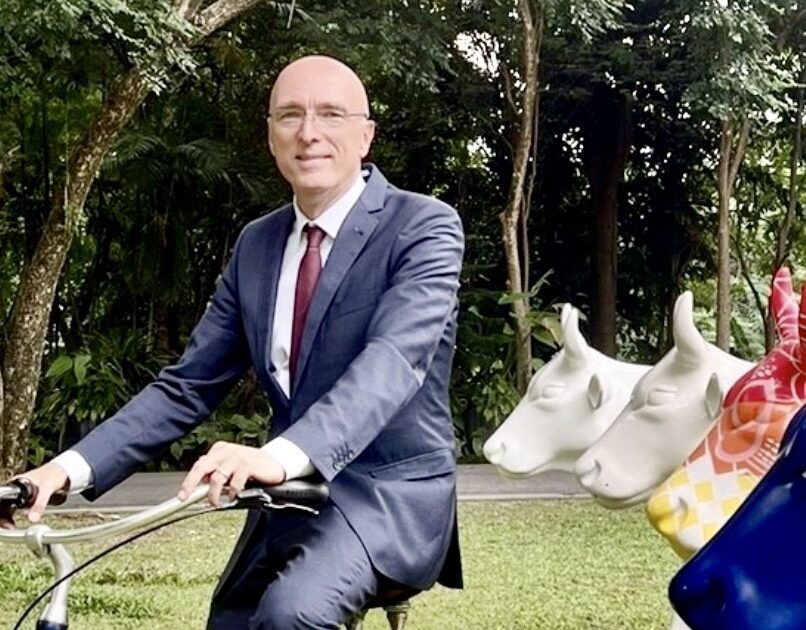NEDERLANDSE AMBASSADEUR WIL BANGKOK OP DE FIETS HELPEN. En om het goede voorbeeld te geven, springt ambassadeur Remco van Wijngaarden – strak in het pak, maar soepel – op de dienstfiets van de residentie. Zo. Dat doet geen ambassadeur in Bangkok hem na. De Nederlandse kunststof-koeien kijken tevreden toe. Een Hollandse idylle in hartje Bangkok.
‘Op de Nederlandse compound gebruiken we de fiets om snel van het ene gebouw naar het andere te gaan. Van kantoor en kantine naar portiersloge. Of van oude residentie naar nieuwe ambassadeurswoning. Maar we gaan er niet mee de straat op. Te gevaarlijk.’
De ambassadeur gaat wel graag uit fietsen met z’n gezin. Dan gaan ze even verderop naar Lumpini Park of Benjakitti-park. Of ze laten zich begeleiden door iemand als André Breuer van Bangkok Biking, die tochten aanbiedt op veilige routes.
Maar op de fiets naar de internationale school, ook niet ver weg, is door het chaotische verkeer ondenkbaar.
BIJ SCHOLEN STAAT VERKEER MUURVAST
In Bangkok brengen je ouders je overal naar toe. Liefst met de auto. Als de scholen beginnen en uitgaan, staat het verkeer tot in wijde omgeving muurvast.
De mobiliteit in de miljoenenstad heeft z’n grenzen al lang bereikt. En nog steeds neemt het aantal auto’s toe – vaak aangeschaft op afbetaling.
Remco van Wijngaarden: ‘Dat is een bekend verschijnsel als de welvaart toeneemt. Maar je ziet als volgende stap al dat Thai dure sportfietsen kopen. Gaan ze in groepsverband mee rijden in een van de fietsparken. Dat maakt woon-werkverkeer op de fiets makkelijker bespreekbaar.
NOG GEEN 4% THAI HEEFT FIETS
Meer ruimte voor fietsers is een van de 214 prioriteiten van Bangkoks ambitieuze gouverneur Chadchart Sittipunt. Want fietsen in plaats van autorijden betekent meer mobiliteit, een beter milieu en een betere gezondheid.
Toen de ambassadeur met hem kennis maakte, vroeg Bangkoks politieke baas nieuwsgierig of fietsland Nederland expertise kan leveren. Dat wil Nederland met genoegen doen.
‘We hebben op fietsgebied natuurlijk veel ervaring. Amsterdam heeft meer fietsen dan inwoners; 70% van alle vervoersbewegingen is fietsverkeer. Slechts 3,4% van de Thai heeft een fiets. De meeste daarvan zie je in dorpen. Niet in Bangkok.’
‘Nederland weet alles over noodzakelijke infrastructuur. Over fietsbanen, fietspaden en fietsenstallingen. Over hoe je verschillende soorten vervoer van elkaar scheidt en tegelijkertijd op elkaar aansluit. En we hebben zelfs een publiek-private stichting, die buitenlandse steden gericht kan adviseren.’
‘Bangkok helpen levert goodwill op. Juist daar waar we ons willen onderscheiden: Op gebied van duurzaamheid en milieu. Dat is goed voor de handelscontacten.’
OP FIETS NAAR WERK ZONDER ZWETEN
Remco van Wijngaarden ‘Natuurlijk is aanleg van fietspaden in volgebouwd centraal Bangkok niet makkelijk. Maar elders in de metropool kan het sneller. De lijnen van skytrain en metro strekken zich steeds verder uit. Daar kunnen fietspaden en stallingen leiden tot een keuze voor reizen per fiets en trein’
‘En wat dacht je van de introductie van de elektrische fiets? Die kan een groot bezwaar wegnemen: Je komt niet meer bezweet op je werk aan’
Met een kleine duw in de goede richting, zegt Remco van Wijngaarden al tevreden te zijn. Gelijk heeft hij. Leerden we niet allemaal zo fietsen?
FIETSEN IN BANGKOK ZAAK VAN LANGE ADEM
Later krijgen geïnteresseerde Thai in de tuin van de ambassade een film te zien over fietsen in Nederland. Voor hen is het een SF-film. Met fietspaden dwars door de stad. Met fiets-verkeerslichten. Fiets-snelwegen tussen steden. En fiets-parkeergarages.
Zo is het in Bangkok nog lang niet, constateert een panel met daarin ook fietstioer-ondernemer Andre Breuer van Bangkok Biking. Hij kent als geen ander de belemmeringen voor fietsers. Door niet over te steken brede, drukke wegen. Onoverzichtelijke kruisingen. Doodlopende straten. ‘We bieden prachtige recreatieve routes door mooie stukjes stad. Maar woon/werkverkeer is een zaak van lange adem.
Suggesties die het panel mee geeft aan de lokale autoriteiten: Begin met fietspaden in een wijk en creëer zo een modelproject, zodat mensen zien wat de voordelen zijn. Bouw een fietsenstalling bij het dichtsbijzinde station van skytrain of metro. Probeer doodlopende straten met elkaar te verbinden, bijvoorbeeld via tempelterreinen. En, oh ja, plant bomen langs fietspaden voor welkome schaduw!
> Opmerkelijke Thaise berichten lees je in onze Facebookgroep Typisch Thailand Telex
